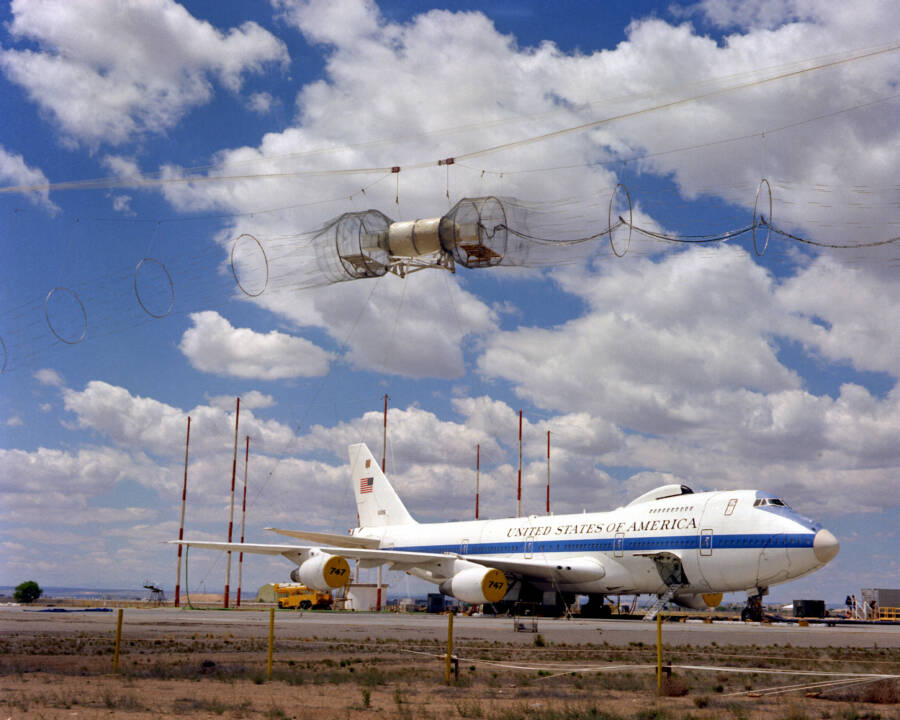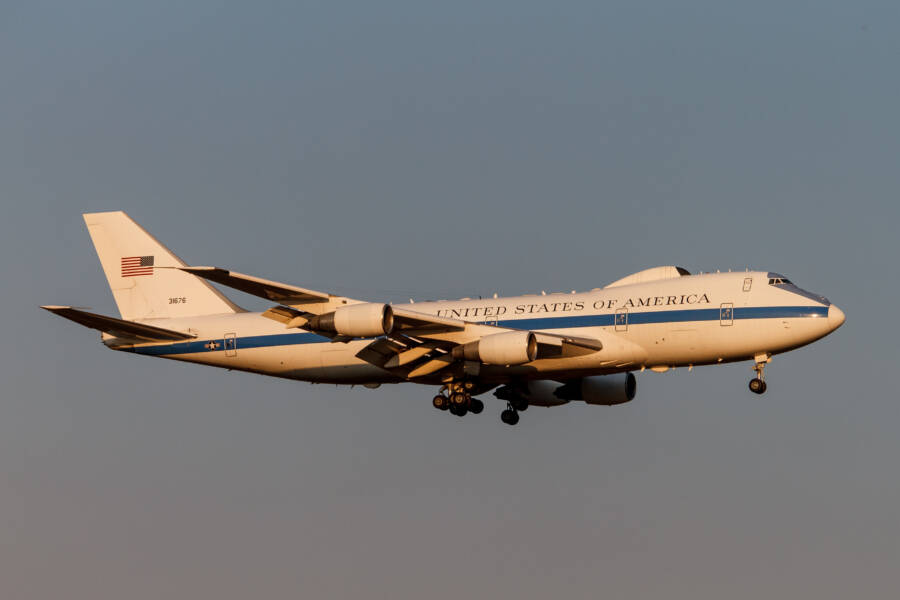The Boeing E-4B Advanced Airborne Command Post, more commonly called the “doomsday plane,” was constructed during the Cold War as a nuclear contingency plan.

Wikimedia CommonsThe Boeing E-4B, also known as the doomsday plane, is meant to serve as an aerial command center in times of crisis.
Since the invention of nuclear weaponry and its implementation during World War II, the world has been forced to wonder about the threat of impending nuclear war. This was the impetus for the Cold War, when tensions between the United States and the Soviet Union threatened to push the world ever closer to this grim fate.
As such, the United States military established a number of contingency plans should the country find itself in a potentially nuclear conflict. One of these defensive measures has been dubbed the “doomsday plane,” though to be more accurate, it is a series of planes meant to serve as a flying base of operations resistant to nuclear radiation.
Officially known as the National Airborne Operations Center (NAOC), the four E-4Bs — modified Boeing 747-200s — are also referred to as Nightwatch planes, each equipped with top-of-the-line communications equipment to allow the military’s top officials to maintain control in the wake of a nuclear crisis.
Here’s everything you need to know about the U.S. military’s doomsday planes.
Why Does The U.S. Have Doomsday Planes?
Although their role in a potential nuclear crisis is the most touted use case for the U.S. military’s E-4Bs, they are not strictly limited to that purpose. Certainly, the Cuban Missile Crisis highlighted the need for some sort of crisis plan, but doomsday planes have evolved in the 60 years since to serve a litany of defensive purposes.

Wikimedia CommonsAn E-4 advanced airborne command post on an electromagnetic pulse (EMP) simulator for testing.
As reported by the Air Force Times, the mission of America’s doomsday planes was initially to direct military assets during the Cold War. They were only equipped with the necessary communication devices required for national leaders to get in contact, but the military quickly realized the potential benefits of a mobile military command center.
Now, the planes are something of a Swiss Army Knife — an all-in-one mobile command station equipped to handle numerous war-related crises, though this implementation has yet to be fully utilized. These massive jets have 5,000 square feet of mobile office space, including secure conference rooms, media briefing rooms, and cots. They can remain airborne for days at a time, during which national security experts could theoretically stay in communication.
The E-4Bs are also equipped with windows covered in a mesh that protects against electromagnetic shockwaves sent out by nuclear blasts, and the cockpit contains specialized masks to prevent pilots from being blinded by these explosions as well.
Moreover, the jets undergo rotating 30-day periods of heavy maintenance to ensure they are always at the ready.
“This jet does not shut down — 24/7, 365, there’s folks back there making sure that those 42 disparate communication systems are connected when they need to be connected, and they’re constantly maintaining those,” Lieutenant Colonel Mike Shirley told Air Force Times. “They’re also receiving notifications, receiving messages and providing that information to the battle staff.”

Wikimedia CommonsAn illustration of the internal layout inside the U.S. Air Force’s doomsday planes.
Each jet can fit a crew of 65 people, and depending on the needs of those on board, they can connect to any phone number, tune in to any radio or television singles, read text messages, and broadcast video, ensuring that any VIPs on board can reach anyone they need to be in contact with.
To some, it may seem like the need for such a contingency plan is overkill, but military officials and experts have stated that the Nightwatch program is a benefit for monitoring all situations, not just those that could lead to nuclear Armageddon.
“The plane provides a level of physical security and resilience, and the national command authority, that I think is still entirely relevant and appropriate,” said Todd Harrison, a military aviation expert at the Center for Strategic and International Studies.
The Evolution Of The Doomsday Planes
The planes were initially conceived in 1973 under the designation E-4A, per Interesting Engineering, with the first official E-4B model being delivered by Boeing in December 1979. Over six years, the three E-4A models were converted to be in line with the E-4B, and they have been iterated upon since.
The initial rollout of E-4B jets was estimated to have cost roughly $250 million, but in 2005, the U.S. Air Force granted a five-year, $2 billion contract to Boeing for the ongoing modernization of the doomsday planes. In addition, the Air Force was required to pay roughly $160,000 per hour to operate the aircraft.

Wikimedia CommonsThe Air Force is currently developing a replacement to the E-4B, but it is unclear when a new program will be put in place.
However, despite modernization efforts, this doesn’t change the fact that the E-4Bs originated in the 1970s and are more than 20 years past their expected lifespans. It’s clear that the military sees a value in keeping some sort of aerial command center around, but the question remains whether the NAOC, in its current form, will remain a viable option.
Evidence would seem to suggest that it is not.
In fact, former U.S. Secretary of Defense Donald Rumsfeld initially expected all four planes to be retired in 2009, though this never happened. One plane was retired in 2007, then later brought back into service because, as then-Secretary of Defense Robert Gates said, “the planes have such unique capabilities.” Notably, the planes’ use of analog equipment makes them less vulnerable to hacking.
In 2021, the Air Force began developing a platform that could replace its current doomsday planes, known as the Survivable Airborne Operations Center (SAOC). As of early 2022, this program was still “in the very early stages of development,” the Air Force said, but it also requested $203 million for research, development, testing, and evaluation for the program as part of its budget request for 2023.
This amount more than doubled its 2022 request of $95 million and quadrupled its 2021 request of $50 million. Predictions from the Future Years Defense Program estimate that funding will only continue to grow, possibly reaching as much as $610 million in 2024 and $856 million in 2025.
However, several committees have raised concerns over the timeline and whether the SAOC will be ready before the NAOC reaches the true end of its life cycle. For now, though, the current iteration of the doomsday plane is here to stay.
After reading about the U.S. military’s doomsday planes, learn about the Russian weapon nicknamed the “Doomsday Machine,” allegedly capable of creating 300-foot waves. Or, read about Starfish Prime, when the U.S. detonated a nuclear bomb in space.





